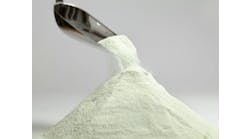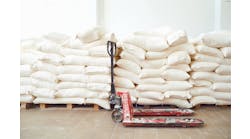A lot of people think of food as benign and harmless – certainly nothing that can explode. Until it does.
Dust explosions are among the most overlooked hazards in food processing. One of the most notorious ones occurred in 2008 at the Imperial Sugar refinery near Savannah, Ga., killing 14 people and injuring 42 more.
“One of the problems with foodstuffs is, people know foodstuffs and they deal with it every day. Because of that, they tend not to appreciate the dangers,” says Nick Hayes, president of Volkmann USA, a supplier of powder and bulk solids handling equipment.
Hayes says that to minimize the risk of explosion, equipment that handles powder must be designed for two things: to remove all of what he identifies as 13 possible sources of ignition (primarily by making sure the equipment is grounded) and by ensuring that the equipment is as easy to clean as possible.
“You get risk when people have equipment that isn’t easy to clean, that’s difficult to take apart, or when it’s heavy,” he says. That leads to operators taking risks by moving heavy components in awkward body positions, leading to injury.
Then there’s the other risk associated with equipment that’s hard to clean: it won’t get cleaned.
“Human beings are human beings. We avoid doing things that are difficult. That’s the way it is,” Hayes says. “So if you make things hard to take apart or make them difficult to clean, you’re going to be at a disadvantage.”
A bulk bag discharger from Flexicon features an open-channel frame for easier cleaning.
Sanitation encompasses containment and prevention of contamination as well as ease of cleaning, says Dan Capwell, marketing manager at Flexicon.
“Product quality is paramount to food and beverage producers, so they increasingly look for process equipment that eliminates product contamination, while offering reduced cleaning and sanitation times as well as absolute containment of dust and spillage,” Capwell says.
One Flexicon product achieves ease of cleaning by using an open-channel steel frame in place of the usual hollow tubing. The new Bulk-Out Bulk Bag Discharger features stainless steel open-channel construction that reduces the risk of cross-contamination between changeovers and provides unobstructed inspection.
Heavy metal risk
Another potential hazard in powder handling is the risk of contamination by metal fragments. This is especially problematic because it’s often propelled through direct contact with metal components like augers, and because detecting the contamination is particularly tricky.
Metal detection usually is done while the powder is in free fall, most often while it’s being dropped into its packaging. This is partly because packaging is the most logical point for detection, and partly because it’s easier operationally.
“The best way to do it in our experience is to reject in gravity,” says Eric Confer, manager for light industry at Eriez Magnetics. “That way you can limit the amount of rejected material.” When metal is detected, the segment containing it has to be shunted away from the main flow; that’s easier to do when powder is falling than when it’s being pushed through, for instance, a pneumatic conveyor.
Another challenge in metal detection for powders is calibrating the machine. Calibration has to be done by sending test particles of metal, sized according to the sensitivity required by the application, through the detector’s aperture. This is much harder to do with powder than with discrete units like packages, because it’s difficult to time the passage of the test particle and to recover it. If it’s not recovered, it might contaminate the handling or packaging equipment.
The Gravity Flow and Throat powder metal detectors from Mettler-Toledo feature an automatic calibration system.
Mettler-Toledo solves this problem with a test system that features acrylic tubes installed along the outside of the throughput tube, but within an outer, protective tube. The testing tubes contain a metal particle and are positioned so that they run through the detector’s sensing coil. Compressed air, controlled from outside, makes the particle in the testing tube descend past the coil, triggering it to signal that the unit is fully operational.
Metal detection for powders has improved simply because the magnets have gotten stronger, says Dennis O’Leary, chief business development officer for Industrial Magnetics.
“A new magnetic assembly such as a drawer or bullet magnet, which are commonly found in gravity and pneumatic lines, respectively, is so much stronger and more effective at capturing ferrous contaminants than a unit that’s five to 10 years old,” O’Leary says.
Powder purging
Storage of powder prior to processing presents yet another potential hazard. If powder doesn’t evacuate consistently from a storage silo, residue may accumulate and decay. This is especially liable to happen when the powder empties in a “core flow” or “channel flow” pattern, meaning that the center of the mass of powder drops faster than the powder on the outside.
This creates a first-in/last-out situation, where some of the powder lingers a long time (or indefinitely), which is the reverse of the first-in/first-out pattern that’s required in almost all processing. What’s desirable is “mass flow,” where all the powder evacuates evenly. Achieving this is a question of matching the interior wall surfaces and the slope and general design of the vessel to the powder’s characteristics.
“The food industry deals with organic solids materials [such] that if they stagnate, decay can take place,” says Herman Coello, product marketing manager for level products at Siemens Industry. “Thus, when dealing with cohesive and degradable powders, it is imperative that the silo or hopper is designed for a mass flow pattern.”
Coello adds that proper level sensing equipment can keep track of what’s in a silo without requiring it to be opened up, which is hazardous and interrupts operations. A few years ago, Siemens introduced a radar level sensor that operates at 80 GHz, emitting a narrow signal that could more reliably reach the bottom of a deep, narrow silo – the kind best suited to achieve mass flow with many kinds of powder.
Flow flaws
The challenges in handling powders extend beyond storage vessels. Variations in moisture, particulate size and shape and other parameters can lead to problems like sticking, bridging and clumping as the powder moves along a line. These can interfere the powder’s flow, causing processing interruptions or worse.
For a long time, the only way to measure these parameters was through sampling and off-line testing. But increasingly, in-line alternatives are available.
“Recent developments in in-line characterization mean that an increasing number of parameters can now be measured in situ,” says Laura Monington, applications specialist for Freeman Technology, a provider of flow-measurement technology. “The ability to make decisions without waiting for off-line results to be generated and interpreted means that critical process parameters such as impeller speed, transfer rate, component addition rates and environmental conditions can be rapidly adjusted to achieve and maintain optimal output.”
For example, a critical parameter is drag force flow, which is a measurement of the forces associated with movement of powder. It’s a function of material properties such as size, density, adhesion and strength. Freeman distributes a sensor from Lenterra that can be applied to operations such as blending, granulation, spray dying and feeding to determine drag force flow.
“Quantifying this property continuously in real time allows operators to react to changes and make necessary adjustments without interrupting the process,” Monington says.
Powder is one of the trickiest materials in food and beverage processing to handle safely. But the right equipment, combined with the right knowledge and awareness of the challenges and hazards, can make safe, consistent handling achievable.


